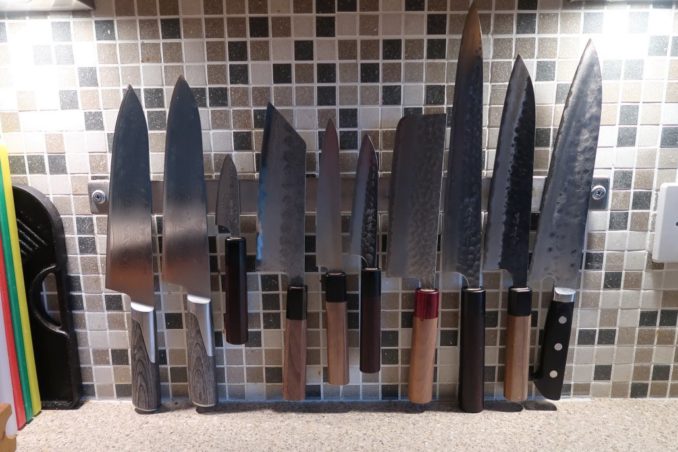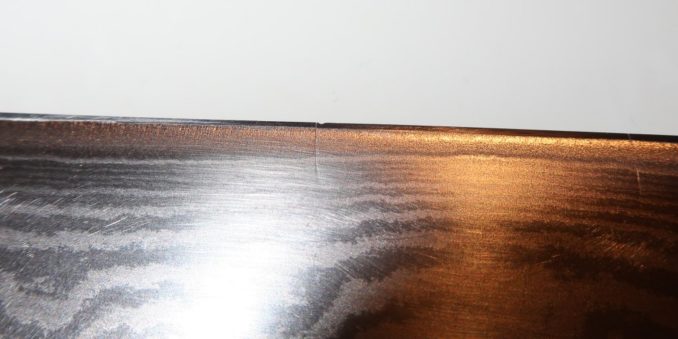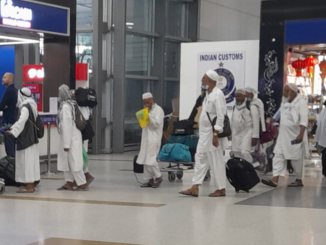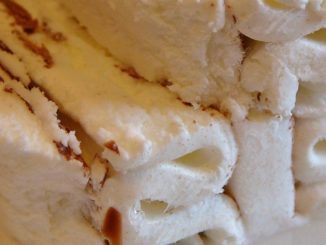I’ve browsed this site for a couple of years, but have contributed very little other than stupid comments. Figured it was time I contributed a bit more.
Firstly… My name is Bertram and I have an unhealthy obsession with Japanese knives. In fact, this is what’s on our kitchen wall (it is so dirty as we’re having new tops fitted soon)!

So… Japanese knives. My first experience of Japanese knives was when I spent some time in Japan on business far too many years ago now. Looking around a department store in Tokyo, I couldn’t believe the price of some of the knives on show. I had to translate between Yen and Pounds and they were hundreds of Pounds each. Why on earth would anyone pay that for a lump of metal? It just cuts right? I have knives at home that do that…
Fast forward more than a few years and I had started to do much more cooking and had purchased an Edge Pro sharpening system for the “extra-special” £40 Ikea VG-10 Damascus knives (which really aren’t bad when you get them sharp and are the two on the left of the picture above) I’d bought. A year or so later, I ended up with a little extra money come in so wanted to buy a “special” knife. As it happens, I had a small supplier of Japanese knives fairly close to me (no longer in business unfortunately) who had some interesting knives. I took a trip and bought the two knives on the right of the picture above. But before we get there, let’s cover some background on knife technology.
Knife manufacturing
How do you make a knife? Simply, take a lump of metal and bash it into shape. You can do that in a variety of ways, ranging from hitting it with a big industrial stamping machine, through to hand forging in the traditional way. Perhaps unsurprisingly, the stamping machine is way more efficient than the hand forging, but then that’s part of the individuality of a hand-crafted knife (the more expensive knives are hand forged to a greater or lesser extent). But that isn’t the whole story.
You want a knife to be sharp – right? And to maintain that sharpness for as long as possible. A sharp knife is a pleasure to use and once you learn to keep fingers out of the way – safer. So, how do you make a knife that stays sharp? Simply put, it is selection of the underlying metal combined with the way it is manufactured.
Metal selection
Most knives that are hand made (and we’re concentrating on hand made here) are made from steel. But which steel? Ease of use would make you choose stainless. It is fairly hard and maintains an edge reasonably well, but there are better steels out there for cutting edges on kitchen knives. These are non-stainless high-carbon steels. But that’s not great because they will develop a patina and ultimately rust if not looked after, which is not great for today’s modern life. There is one steel that is an exception to this, a stainless steel called ZDP-189, but more on that later.
Why do high-carbon steels do better as cutting edges? Primarily because they are more brittle. Wait – they are more brittle? Surely you don’t want that. Oh, but it has its advantages. The crystalline structure lends them to being sharpened to a finer angle and holding that edge for longer assuming you treat them well. If you treat brittle knives badly, they will suffer damage more easily. This damage will appear as cracks or small sections of the cutting edge missing which basically means an expensive knife that doesn’t cut very well in very short order. The next picture shows a closeup of the edge our first Ikea knife.
There are two things to note: first, the vertical hairline cracks. I have no idea how they happened, but I suspect this knife got some abuse and rougher treatment as it was the first “sharp” knife we owned. It still cuts fine when sharp though. The second thing to note is the nick in the blade edge. These happen from time to time on all of the knives we have and result in there being a point that drags when you use it to slice. It makes the knife feel like it is constantly catching.

Fortunately, this was a relatively cheap knife, so I don’t really worry about it. The moral of the story though is if you want to invest in these knives, you need to treat them well!
Metal ratings
There is a way to measure how hard a metal is, and that’s the Rockwell scale. The Rockwell scale for knife blades is denoted as HRC where the C stands for which “scale” the measurement is made against. Steels used for premium knives tend to rate between 57 and 67 HRC, whilst cheaper knives will rate in the low to mid 50’s. “Premium cheap” stainless knives will probably top out at 60 HRC – still very capable, but they are limited in how far they will keep their edge. Whilst it is perfectly possible to get an incredibly sharp edge on almost any knife, the longevity of that edge will be determined in big parts by its HRC (and how it is treated). High-carbon steels, together with other elements like Molybdenum, Vanadium and Tungsten in small amounts make different mixes of steels.
Japanese steels tend to have esoteric names such as “White #1” or “Super Blue” which denote their individual makeup. Knife manufacturers may make a couple of ranges of knives which may use different steels and charge prices accordingly.
Unfortunately, everything, like life, competes. The best steels for knife making are corrosive, so not great for ease of maintenance and normally need to be used carefully. No twisting or moving the food to one side whilst dragging the blade. They also tend to be more difficult to work with to manufacture and require careful annealing where the metal is heated and quenched in liquid to improve strength.
So, manufacturers have a choice when making knives – go for stainless because it is versatile but won’t hold the sharpest edge or go for high-carbon steel which tarnishes.
There is a third option. Make the core of the blade in the metal that is best suited to cutting and then wrap it in a stainless outer. This gives the benefit of both worlds, but takes longer to manufacture. This is the knife blade I prefer. Often these blades are manufactured with multiple stainless steel layers which are then gradually ground out to give a wavy line effect on the blade known as a Damascus finish. Here is a close-up of the Damascus style layering on two of the knives we have here:

Some manufacturers are incredibly competent at this and can produce some very beautiful knives – often at very high prices!
Probably the most common “decent” stainless steel we see here in the UK is a steel named VG-10. This is a very good stainless steel which has a number of desirable properties. First, it is stainless so easy to maintain. Secondly it is relatively easy to work and thirdly it has a relatively high HRC at around 60. Additionally, it tends to be made in a Damascus style and knives in that style do look good. It is a good all-rounder.
What of the higher end continental knives like Wusthof and Sabatier – I think they use stainless at the high 50’s HRC. Good, but not great, but then they are relatively cheap (relatively is relative here! I view anything under £100 for a knife as cheap…).
Handles
There are two types of handles that are available on Japanese knives and are referred to in the Western world as traditional or western. The traditional handle (or Wa handle) is generally either an oval/ovalish or octagonal straight piece of wood with a collar, normally of some contrasting material. It is the handle you’d associate with a traditional Japanese knife. The Western handle is, as you might suspect, shaped like a Western knife handle. Typically, it has 2 or 3 rivets through a wood or acrylic handle attaching the handle to the tang (the metal bit of the knife that runs through the handle).
We have mostly Wa handles on our knives – you will see that later in the pictures.
Cutting edge profiles
Cutting edges, when you look along the cutting edge, have two distinct shapes, either a double-bevel where the knife is sharpened on both sides to a V shape or a single bevel where one side is left unsharpened and the other is sharpened to it. The latter blades are handed, and it is possible to pick up right or left handed versions of these single sided blades. Both blade shapes cut, but the single edged blades are designed for cutting raw meat primarily and using the Japanese style push cut where the knife is pushed away from you when the flesh is cut rather than the more instinctive pull cut we Europeans tend to do. Personally, I own no single bevelled knives – I don’t deal with raw fish where they excel and my partner is left handed so we couldn’t really swap blades easily.
Knife blade shapes
You can literally get dozens of knife shapes, all designed for a different job. I will cover the most useful Western shapes as there are dozens of sites out there that cover all shapes.
The most popular (and what I bought first) is a chef’s knife or a Gyuto which looks and feels like our standard cooking knife, although the top of the knife curves down to meet the tip unlike more traditional German style where the blade curves up to meet the (generally) straight spine. Coming in sizes from 180mm (around 7 inches) to typically 270mm (around 11 inches) the most popular sizes tend to be the 210mm and 240mm knives (I have both sizes). They are great all-rounders.
Probably the knife people buy next are Petty knives. These are small (80mm to 150mm) low-profile knives you would use for general light work. They are also the sort of knife you’d reach for when microwaving ready meals, but that’s a really expensive way of piercing plastic!
Then, it depends on what you are after. A typical knife most will have heard of is the Santoku which is flatter than a Gyuto and shorter as it tends to max out at 180mm, but there is also a similar knife which tends to have a flatter blade and more aggressive tip called the Bunka. They do the same sort of thing, but the Santoku is slightly more curved so will suit a rocking cutting motion better.
Carving knife – sure. Sujihiki. Tends to be long, thin and have a lowish profile blade. Awesome for slicing the roast beef on a Sunday. I have a 270mm one but would have liked a 300mm one but couldn’t find one when I looked.
Then you have a Nakiri. This is a very flat bladed knife which looks like a mini-cleaver but isn’t with a rounded tip designed for cutting or chopping vegetables. Again, tends to be 150 to 180 mm long and is used in a more up/down motion.
There are loads of other specialist shapes, depending on what you want and most knives come in a single-bevelled version. For example, the Yanagiba is essentially the single-bevelled version of the Sujihiki but is designed for slicing sushi.
Availability and cost
This is where it gets painful. You can buy mass-produced Japanese knives and they tend to be relatively cheap, made from a stainless mix and mass produced.
Then you get to hand made. And you have two options now, produced by a company that still hand-makes their knives but it is run as a factory or hand made by one or two people (typically, there will be a knife maker, handle maker and a sharpener or sometimes simply a knife maker who does everything).
Guess what.
As the number of people hand-making knife decreases, availability decreases worldwide (the USA are big Japanese knife fans) so prices and lead times increase. I have seen knives go out of stock with lead times of 12-18 months and I have also seen a single knife come into stock at a retailer. Not that I was looking for a knife but I have had a marketing mail from a company I use fairly frequently and by the time I clicked the link a few hours later, the handful of knives they had were gone and probably won’t be back in stock for a year. Most knives on my most used shopping site are “out of stock”.
Basically, these things can be quite rare items. They command a premium then. To buy anything hand made from a “decent” manufacturer where the team have made it, be prepared to spend £100-£300+ depending on the knife. If you have a named maker, start at £150ish for the easier to manufacture and smaller knives and just go as high as you’re prepared to pay. Heck, my cheapest no name mass produced knife cost £90 and the most expensive were I to buy it today (I bought it 6 years ago and got a good price) would cost well in excess of £500. If you could buy it that is – I haven’t seen one in stock for a few years now and the last one I saw in the UK was £550.
Well, I’ve seen on various knife forums that knives are like guitars. You can never have too many as they are all different! However, I am now the proud owner of 7 Japanese knives. Most of these are high-carbon steel clad in stainless with a couple of stainless only knives. You’ve seen them on a rack, but here’s what we have:

From the top…
270mm Anryu Aogami Sujihiki. Lovely knife that gets used for carving the roasts. Made by Anryu-san from Blue steel #2 to an HRC of 62. Can carve slivers of meat easily, so great for the cheaper bits of beef which are very chewy if cut thickly. The hammered finish it has shows how it was made as well as helping food not stick.
240mm Teruyasu Fujiwara Maboroshi gyuto (my pride and joy) which is a brute of a knife when you need it to be. Actually named by Fujiwara-san as Maboroshi no Meito or “Visionary Sword Celebrated in Victory” which is one heck of a claim! Made from Shirogami #1 which is a very hard steel so a PITA to get really sharp. HRC 65-66, so needs to be treated with care. The slight nick at the back of the blade is for comfort as when you use a pinch grip, it is where the middle finger sits. Made by Fujiwara-san and tends to be used when working with raw meat or larger veg. Ms G won’t touch this knife!
210mm Masakage Koishi Gyuto. Koishi translates as “pebbles” and refers to the patterning. It also has a Kurouchi finish which is a traditional “from the forge” black top look to it. Originally used to help reduce corrosion, I think it looks stunning. Beautiful to use as it is thinner and lighter than the Maboroshi so is easier to handle. Made by Kato-san with a HRC of 63-64 and from Aogami Super. Typically used for chopping onions or similar food that you can use a rocking motion with.
80mm Masakage Kumo petty. Made from VG10 stainless and has an HRC of 60-62. Small and light but incredibly beautiful. Meant for peeling/close work. We’ve only just got this so it is still finding its home in our knife collection.
130mm Anryu Aogami Petty. Ms G uses that 99% of the time and is of the same line as the 270mm Suji. Cuts very easily. The picture is very deceptive – in real life, it looks like a small version of the top knife and is not that colour at all.
170mm Hatsukokoro Inazuma Bunka. Super blue steel, HRC 62-63. made by a “leading master blacksmith” who “has created this range for Hatsukokoro and due to existing partnerships between the blacksmith and their other partners we’re not able to name him”. Beautiful knife to look at and hold (this was the close up Damascus knife above). Lovely cutting edge from the box and much easier to use than a Petty when moving tomatoes or cucumber around due to the deeper blade. Great for chopping rather than a rocking slice due to the flatness of the blade. Also looks as mean as heck with that nose on it.
170mm Tsunehisa Nakiri. Super blue steel clad in a traditional stainless pattern, it runs at 63-64 HRC made by un-named blacksmiths, but holds an edge well. Sharpened to within an inch of its life, it chops the Sunday roast veg very well! Again, more suited to a chopping motion rather than slicing or rocking due to the blade shape.
Other knives? Yup – in the drawer… I also have a Spyderco Paramilitary 2 which I use as a letter opener/cardboard cutter/cellotape breaker on parcels. That gets blunter quicker, but then it’s an HRC of 56 or 57 from memory.
Use
Both Ms G and I use these knives to the exclusion of others. We no longer any of the other knives we have as they are clearly inferior in use. What does a nicely sharp knife feel like to use? Absolutely lovely! Occasionally, Ms G will get one of the two Ikea £40 knives, but that will be to chop something bigger. Ms G normally uses the 130mm petty and then uses the Nakiri when doing larger veg. I tend to use the Bunka if I’m just chopping a tomato or something that sort of sized, and the two Gyutos if dealing with raw meat. The Suji is always used to carve cooked meat.
Keeping things sharp
It is pointless spending this sort of money on knives if you aren’t going to keep them sharp. Whilst most of these knives are extremely sharp out of the box, they will dull as the blade wears. Things gradually get more difficult to cut and the knife gets more difficult to use.
I mentioned way up in the article about the wonderous ZDP-189 which has an HRC of 67. You can get knives in this metal but due to the extreme hardness, it has a reputation for being a PITA to sharpen. – and there are other stainless metals at around 62-63 HRC like R2 and SG2 but why make your life easy… I don’t have any knives in these metals, despite them being available in some of the knife shapes I want. I think it is a case of wanting to be a bit more traditional as well as ZDP-189
I’ll get around to penning another article on knife basics as well as a discussion of my sharpening journey, but that is for another day and another article…
© text & images Bertram Gilfoyle 2021
The Goodnight Vienna Audio file



